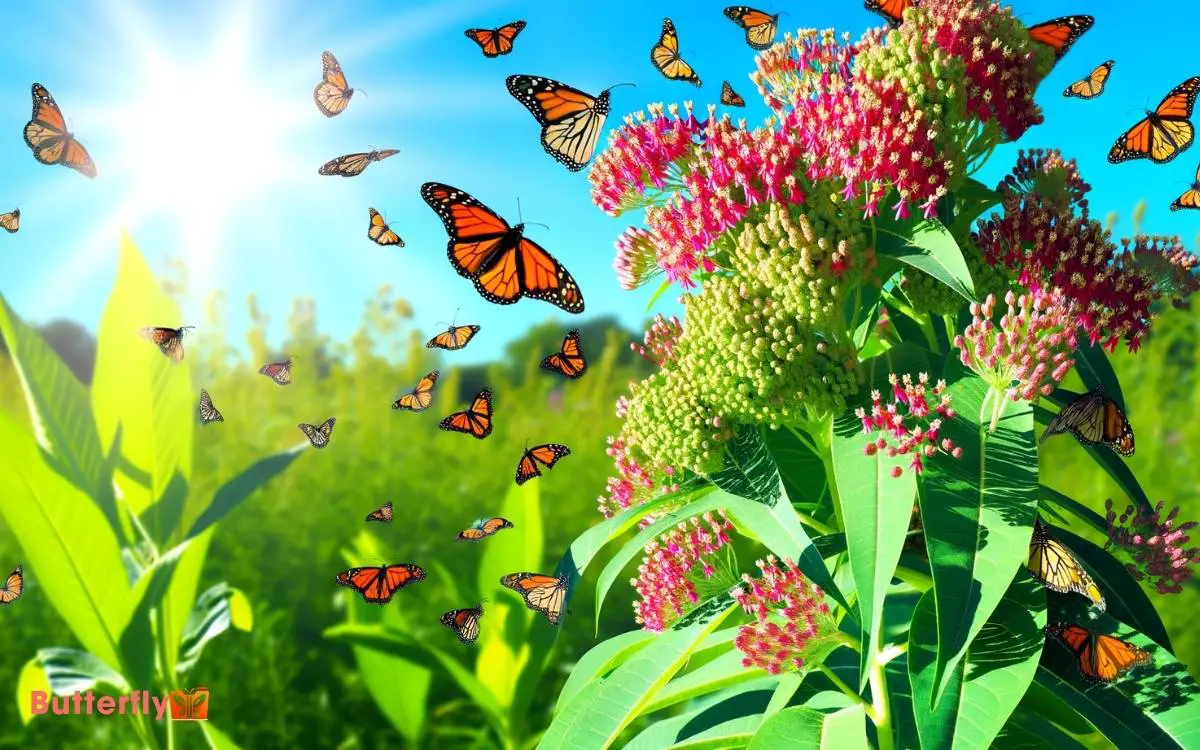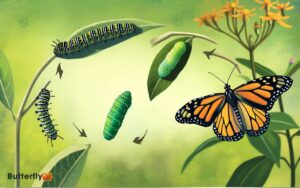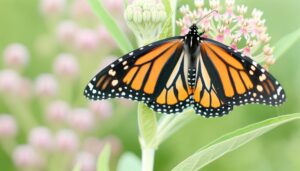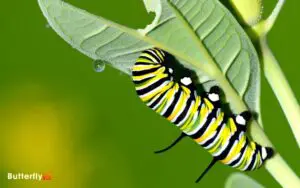Milkweed Plant and Monarch Butterflies: Discover Connection!
You’ll find milkweed essential for the survival of monarch butterflies. Monarch females lay their tiny, pale-green eggs on milkweed leaves.
Once hatched, larvae feed exclusively on milkweed, which provides not only nutrition but also toxic compounds essential for their defense.
Milkweed nectar supports adult monarchs during their migrations. Different species like Common Milkweed (Asclepias syriaca) and Butterfly Weed (Asclepias tuberosa) thrive across various habitats. Without milkweed, monarch populations face severe risks.
To support these butterflies, consider planting native milkweed and avoiding pesticides, aiding both conservation and biodiversity. Explore more on how to make a significant impact on their lifecycle.

Key Takeaways
The Life Cycle of Monarchs
The life cycle of monarch butterflies begins with a tiny, pale-green egg laid on the underside of a milkweed leaf. You’ll notice that each egg is about the size of a pinhead. Within 3-5 days, a larva, or caterpillar, emerges.
This caterpillar has distinct black, white, and yellow stripes. It molts five times, growing larger with each molt, a stage called instar. After about two weeks, the caterpillar finds a safe spot to form a chrysalis, a jade-green casing where metamorphosis occurs.
Over the next 10-14 days, inside the chrysalis, the transformation from caterpillar to butterfly happens. When the monarch finally emerges, it hangs to let its wings dry and harden before it takes flight, completing the cycle.
Importance of Milkweed
You’ll find that milkweed is essential for monarchs as it serves as their primary food source during the larval stage.
Beyond nutrition, these plants provide indispensable habitat and support for the surrounding ecosystem.
Conservation and planting efforts for milkweed are necessary to sustain monarch populations and biodiversity.
Monarchs’ Primary Food Source
Without milkweed, monarch butterflies wouldn’t survive, as it serves as the exclusive food source for their larvae. Monarch caterpillars rely on milkweed’s leaves for nutrition, ingesting its toxic compounds to deter predators.
This unique plant-monarch relationship is essential; without milkweed, larvae can’t develop into butterflies. Milkweed contains cardenolides, which are toxic to most animals but essential for monarchs’ defense mechanism. It helps them become unpalatable to birds and other predators.
When you see monarch eggs on milkweed leaves, you’re witnessing the start of this critical process. Monarchs also depend on milkweed flowers for nectar, providing energy for their long migrations.
Understanding milkweed’s role in monarchs’ lifecycle highlights the importance of conserving these critical plants for butterfly population sustainability.
Habitat and Ecosystem Support
Milkweed serves as a cornerstone in various ecosystems, supporting not only monarch butterflies but also a diverse array of pollinators and wildlife. You’ll find that this plant is crucial for bees, beetles, and birds, providing nectar and habitat.
Its intricate flower structure attracts numerous insects, enhancing pollination efficiency. Milkweed’s dense foliage offers shelter for small mammals and birds, while its roots stabilize soil against erosion.
Moreover, the plant produces a toxic latex that deters herbivores, indirectly safeguarding other flora.
Conservation and Planting Efforts
In recognizing the critical role of milkweed, concerted conservation and planting efforts become essential to guarantee the survival of monarch butterflies and other dependent species.
By planting milkweed, you directly contribute to creating crucial breeding grounds for monarchs. The nectar-rich flowers support various pollinators, enhancing biodiversity.
| Effort Type | Purpose | Impact |
|---|---|---|
| Habitat Restoration | Re-establish native milkweed | Boosts monarch population |
| Community Gardens | Increases urban milkweed sites | Supports local pollinator diversity |
| Educational Programs | Raises public awareness | Promotes widespread conservation actions |
Accurate identification of native milkweed species is essential. You should prioritize planting species native to your region to maximize ecological benefits. Through these efforts, you play a critical role in preserving an essential component of the ecosystem.
Types of Milkweed Plants
You’ll find various milkweed species, each with unique attributes, important for supporting monarch populations.
Common milkweed varieties like Asclepias syriaca offer essential habitat, while tropical milkweed, Asclepias curassavica, poses ecological risks.
Opting for native milkweed species can greatly benefit local ecosystems and monarch conservation efforts.
Common Milkweed Varieties
As you explore the diverse world of milkweed plants, you’ll encounter several varieties, each with unique characteristics that play crucial roles in the life cycle of monarch butterflies.
Common Milkweed (Asclepias syriaca) is prevalent in North America, distinguished by its broad leaves and pink to purplish flowers.
Swamp Milkweed (Asclepias incarnata) thrives in wetter conditions, featuring narrow leaves and clusters of deep pink blooms.
Butterfly Weed (Asclepias tuberosa) stands out with its vibrant orange flowers and preference for dry, sandy soils.
Showy Milkweed (Asclepias speciosa) boasts large, fragrant flowers with pink and white hues.
Each variety provides essential habitat and food sources for monarch caterpillars, underscoring the importance of preserving these plants in natural ecosystems.
Tropical Milkweed Risks
While various milkweed species benefit monarch butterflies, Tropical Milkweed (Asclepias curassavica) poses unique ecological risks that require careful consideration.
This non-native species can disrupt monarch migration patterns by blooming year-round in warmer climates.
Continuous availability of Tropical Milkweed can encourage monarchs to breed out of season, increasing their exposure to diseases like the protozoan parasite Ophryocystis elektroscirrha (OE).
Additionally, the plant’s persistent presence can lead to local monarch populations becoming non-migratory, thereby reducing genetic diversity.
You should also note that Tropical Milkweed can hybridize with native species, potentially altering local ecosystems.
To mitigate these risks, it’s important to manage the growth of Tropical Milkweed by cutting it back periodically or, ideally, opting for native milkweed species.
Native Milkweed Benefits
Native milkweed species, such as Common Milkweed (Asclepias syriaca) and Swamp Milkweed (Asclepias incarnata), offer essential habitat and food resources for monarch butterflies, supporting their lifecycle and migration.
You’ll find that these plants provide crucial nectar for adult butterflies and essential leaves for monarch caterpillars. By planting native milkweed, you’re directly aiding in the preservation of monarch populations.
Additionally, these species are adapted to local climates and soil conditions, making them resilient and less reliant on pesticides. Their deep root systems help prevent soil erosion and improve soil health.
Native milkweeds also support a variety of other pollinators, promoting overall biodiversity in your garden. Embracing native milkweed fosters a balanced ecosystem, ensuring monarchs thrive.
Threats to Milkweed Habitats
Human activities and environmental changes are greatly endangering milkweed habitats, crucial for the survival of monarch butterflies.
You might be wondering what’s causing this critical issue. Here’s a breakdown:
- Agricultural Expansion: Intensive farming practices eliminate milkweed through herbicide application and land conversion.
- Urban Development: Growing cities and infrastructure projects destroy natural habitats.
- Climate Change: Altered weather patterns affect milkweed growth cycles and distribution.
- Pesticide Use: Widespread use of insecticides harms milkweed plants and non-target species.
These threats reduce the availability of milkweed, essential for monarch larvae to feed and develop.
Monarch Migration Patterns
Each year, monarch butterflies commence on a remarkable migration spanning thousands of miles across North America.
You’ll observe this incredible journey from as far north as Canada to the forests of central Mexico. Monarchs rely on environmental cues such as temperature and daylight to navigate.
Here’s a quick glance at their migration pattern:
| Stage | Location | Timing |
|---|---|---|
| Beginning | Canada and Northern US | Late Summer |
| Migration South | Central US | Early Fall |
| Arrival | Mexico | Late Fall |
| Wintering | Mexican Forests | Winter |
| Return North | Southern US to Canada | Spring |
This table summarizes the stages and timing of their migration. Monarchs need milkweed for breeding along the way, making their journey a delicate balance of survival and reproduction.
How to Grow Milkweed
Growing milkweed in your garden is crucial for supporting the life cycle of monarch butterflies.
To successfully cultivate milkweed, follow these steps:
- Choose the Right Species: Select native milkweed species suited to your region. Common options include Asclepias syriaca, Asclepias tuberosa, and Asclepias incarnata.
- Prepare the Soil: Milkweed thrives in well-drained soil. Loosen the soil to a depth of 12 inches and incorporate organic matter to improve fertility.
- Planting Seeds: Sow seeds directly outdoors in the fall or cold stratify indoors before spring planting. Make sure seeds are covered lightly with soil.
- Water and Sunlight: Provide full sun exposure and water regularly until established. Milkweed is drought-tolerant once mature.
Conservation Efforts
Supporting milkweed plant conservation is essential for ensuring the survival of monarch butterflies and maintaining ecological balance. You can engage in various strategies to protect these critical plants.
| Conservation Action | Impact on Milkweed | Benefit to Monarchs |
|---|---|---|
| Avoid pesticides | Reduces plant mortality | Increases larval survival |
| Plant native milkweed | Supports plant growth | Provides breeding habitat |
| Habitat restoration | Expands milkweed areas | Enhances migration corridors |
Community Involvement
Engaging your community in milkweed conservation efforts can greatly enhance the impact of individual actions on monarch butterfly populations.
To effectively involve your community, consider these steps:
- Educational Workshops: Host sessions to educate about the ecological role of milkweed and monarchs.
- Seed Distribution Events: Organize events to distribute native milkweed seeds, encouraging local planting.
- Citizen Science Projects: Involve community members in monitoring monarch populations and reporting data.
- Collaborative Gardens: Create community gardens dedicated to milkweed cultivation, providing a habitat for monarchs.
Precise, community-driven initiatives can foster a collective sense of responsibility and significantly boost local efforts.
By promoting scientific understanding and active participation, you can help secure the survival of monarch butterflies through concerted milkweed conservation.
Conclusion
You’ve learned how monarchs marvelously metamorphose, the essential connection to common milkweed, and the diverse types of these plants.
You’ve explored the dangers they face and the awe-inspiring annual migration. By growing your garden of milkweed, you can contribute to conservation. Together, communities can collaborate to create enchanting habitats.
With scientific strategies and shared support, we can safeguard these splendid species and their essential ecosystems. Join this journey to preserve the precious pollinators.






